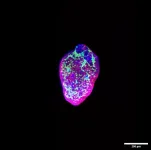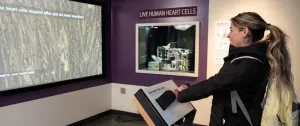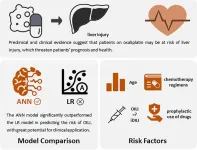(Press-News.org) Multiple sclerosis (MS) is a neurological disease that usually leads to permanent disabilities. It affects around 2.9 million people worldwide, and around 15,000 in Switzerland alone. One key feature of the disease is that it causes the patient’s own immune system to attack and destroy the myelin sheaths in the central nervous system. These protective sheaths insulate the nerve fibres, much like the plastic coating around a copper wire. Myelin sheaths ensure that electrical impulses travel quickly and efficiently from nerve cell to nerve cell. If they are damaged or become thinner, this can lead to irreversible visual, speech and coordination disorders.
So far, however, it hasn’t been possible to visualise the myelin sheaths well enough to use this information for the diagnosis and monitoring of MS.* Now researchers at ETH Zurich and University of Zurich, led by Markus Weiger and Emily Baadsvik from the Institute for Biomedical Engineering, have developed a new magnetic resonance imaging (MRI) procedure that maps the condition of the myelin sheaths more accurately than was previously possible. The researchers successfully tested the procedure on healthy people for the first time.
In the future, the MRI system with its special head scanner could help doctors to recognise MS at an early stage and better monitor the progression of the disease. The technology could also facilitate the development of new drugs for MS. But it doesn’t end there: the new MRI method could also be used by researchers to better visualise other solid tissue types such as connective tissue, tendons and ligaments.
Quantitative myelin maps
Conventional MRI devices capture only inaccurate, indirect images of the myelin sheaths. That’s because most of these devices work by reacting to water molecules in the body that have been stimulated by radio waves in a strong magnetic field. But the myelin sheaths, which wrap around the nerve fibres in several layers, consist mainly of fatty tissue and proteins. That said, there is some water – known as myelin water – trapped between these layers. Standard MRIs build their images primarily using the signals of the hydrogen atoms in this myelin water, rather than imaging the myelin sheaths directly.
The ETH researchers’ new MRI method solves this problem and measures the myelin content directly. It puts numerical values on MRI images of the brain to show how much myelin is present in a particular area compared to other areas of the image. A number 8, for instance, means that the myelin content at this point is only 8 percent of a maximum value of 100, which indicates a significant thinning of the myelin sheaths. Essentially, the darker the area and the smaller the number in the image, the more the myelin sheaths have been reduced. This information ought to enable doctors to better assess the severity and progression of MS.
Measuring signals within millionths of a second
However, it is difficult to image the myelin sheaths directly. That’s because the signals that the MRI triggers in the tissue are very short-lived; the signals that emanate from the myelin water last much longer. “Put simply, the hydrogen atoms in myelin tissue move less freely than those in myelin water. That means they generate much briefer signals, which disappear again after a few microseconds,” Weiger says, adding: “And bearing in mind a microsecond is a millionth of a second, that’s a very short time indeed.” A conventional MRI scanner can’t capture these fleeting signals because it doesn’t take the measurements fast enough.
To solve this problem, the researchers used a specially customised MRI head scanner that they have developed over the past ten years together with the companies Philips and Futura. This scanner is characterised by a particularly strong gradient in the magnetic field. “The greater the change in magnetic field strength generated by the three scanner coils, the faster information about the position of hydrogen atoms can be recorded,” Baadsvik says.
Generating such a strong gradient calls for a strong current and a sophisticated design. As the researchers scan only the head, the magnetic field is more contained and concentrated than with conventional devices. In addition, the system can quickly switch from transmitting radio waves to receiving signals; the researchers and their industry partners have developed a special circuit for this purpose.
The researchers have already successfully tested their MRI procedure on tissue samples from MS patients and on two healthy individuals. Next, they want to test it on MS patients themselves. Whether the new MRI head scanner will make its way into hospitals in the future now depends on the medical industry. “We’ve shown that our process works,” Weiger says. “Now it’s up to industry partners to implement it and bring it to market.”
* The original version of ETH News stated: "So far, however, it hasn’t been possible to visualise the myelin sheaths well enough to reliably diagnose and treat MS. " The statement was clarified on 6.2.2024 as follows: "So far, however, it hasn’t been possible to visualise the myelin sheaths well enough to use this information for the diagnosis and monitoring of MS.
END
Visualising multiple sclerosis with a new MRI procedure
2024-02-08
ELSE PRESS RELEASES FROM THIS DATE:
Cacao of Excellence announces 2023 Cacao of Excellence gold, silver, and bronze award winners
2024-02-08
AMSTERDAM, NETHERLANDS (February 8, 2024) – Cacao of Excellence, a programme of the Alliance of Bioversity International and the International Center for Tropical Agriculture (CIAT) announced today the winners of the 2023 Cacao of Excellence Awards, honouring excellence in the cultivation of cacao, while also supporting and encouraging a more sustainable sector. The full list of Gold, Silver and Bronze winners can be found below and on the Cacao of Excellence website.
The winners were announced ...
How nearly identical RNA helicases drive “mRNA export” via distinct protein complex pathways
2024-02-08
Genetic expression, often leading to protein synthesis, requires a complex coordination of molecular machinery across several stages. A vital step in protein-coding gene expression is messenger RNA (mRNA) export, which involves shuttling mature mRNAs from the cell’s nucleus to the cytoplasm.
The mRNA export process relies on mRNA–protein complex formation, with the evolutionary conserved ATP-bound TREX complex playing a pivotal role. Among its components, the RNA helicase UAP56 is perhaps the most important one during its assembly. Not only does UAP56 participates during mRNA splicing in some transcripts, but it also recruits ...
Heart organoids simulate pregestational diabetes-induced congenital heart disease
2024-02-08
An advanced human heart organoid system can be used to model embryonic heart development under pregestational diabetes-like conditions, researchers report February 8 in the journal Stem Cell Reports. The organoids recapitulate hallmarks of pregestational diabetes-induced congenital heart disease found in mice and humans. The findings also showed that endoplasmic reticulum (ER) stress and lipid imbalance are critical factors contributing to these disorders, which could be ameliorated with exposure to omega-3s.
“The new stem cell-based organoid technology employed will enable physiologically relevant studies in humans, allowing us to bypass animal models and obtain more information ...
New study points to supply chain disruptions if the FDA removes ineffective decongestant from the market
2024-02-08
PITTSBURGH, Feb. 8, 2024 — In a new study of nasal decongestant purchasing patterns, researchers at the University of Pittsburgh School of Medicine found that phenylephrine remained the most popular choice year after year, despite decades of concerns over a lack of evidence supporting its effectiveness.
Published today in JAMA, the research letter points to a coming wave of supplychain disturbances if the Food and Drug Administration (FDA) moves to pull oral phenylephrine from the shelves, as recommended by an FDA advisory panel in 2023 that found the medication ineffective.
The researchers ...
Trends in phenylephrine and pseudoephedrine sales
2024-02-08
About The Study: Despite a lack of clinical efficacy evidence, phenylephrine was the most common oral decongestant in the U.S. from 2012-2021, with hundreds of millions of units purchased by retail pharmacies annually, and sales remained stable during this time. In contrast to pseudoephedrine, which is often formulated as a stand-alone product, most phenylephrine products were co-formulated with antihistamines or antitussives, which are likely to provide some symptom relief for cough and cold symptoms.
Authors: Timothy S. Anderson, M.D., M.A.S., of the University of Pittsburgh, is the corresponding author.
To access the embargoed study: Visit our For The Media website at ...
Visual impairment and real-world home physical activity with home environment in an older population
2024-02-08
About The Study: The results of this study demonstrated that home environment features, particularly lighting, may influence home activity metrics in older adults with visual impairment. Further prospective studies would be needed to confirm if home modifications can improve at-home activity.
Authors: Pradeep Y. Ramulu, M.D., M.H.S., Ph.D., of the Johns Hopkins University School of Medicine in Baltimore, is the corresponding author.
To access the embargoed study: Visit our For The Media website at this link https://media.jamanetwork.com/
(doi:10.1001/jamaophthalmol.2023.6436)
Editor’s Note: Please see the article for additional ...
Stigmatizing language on liver transplant center websites may discourage patients from seeking treatment
2024-02-08
BOSTON – The vast majority of liver transplant centers in the United States use language on their websites that can be considered stigmatizing through their use of words like “alcoholism,” “alcoholic” and “alcohol abuse,’ potentially hindering care and the willingness of patients to seek treatment, a study by Massachusetts General Hospital (MGH) has found.
In highlighting a significant gap between that online usage and the practice recommendations of medical ...
Heart-to-heart connection: Exploratorium and Gladstone bring a breakthrough science exhibit to life
2024-02-08
One of the country’s best-known science museums, San Francisco’s Exploratorium, is located less than three miles north of Gladstone Institutes—a proximity that has resulted in creative, high-science collaborations like the permanent exhibit featured in the latest issue of Stem Cell Reports.
Among the museum’s most popular exhibits, “Give Heart Cells A Beat” opens a rare window into the microscopic world of the beating human heart, using technology and materials made ...
Predictive model of oxaliplatin-induced liver injury based on artificial neural network and logistic regression
2024-02-08
Since 2004, several clinical studies have reported that patients with OXA frequently experienced adverse effects of liver injury (LI), typically characterized by hepatic sinusoidal injury, splenomegaly, decreased platelet count and noncirrhotic portal hypertension, which can progress to nodular regenerative hyperplasia with long-term treatment. LI also decreased hepatic functional reserve and aggravated the postoperative course of colorectal cancer patients after hepatectomy, and may affect intraoperative bleeding, postoperative morbidity, and overall survival. LI can ...
The Galapagos comes to life in new RIT Press book
2024-02-08
Natural scientist and author Robert Rothman takes readers on a reptillian tour of the Galápagos Islands in his new book, A Paradise for Reptiles: Lizards, Snakes, and Giant Tortoises of the Galápagos Islands Vol. 1: Tortoises, Geckos, and Snakes, published by RIT Press.
For more than 30 years, Rothman has led hundreds of Rochester Institute of Technology students on tours to the Galápagos Islands to observe the wildlife and landscape that inspired Charles Darwin’s theory of evolution by natural selection. Rothman’s A Paradise for Reptiles, an homage to the 19th century scientist, is an accessibly written guide for anyone interested in Darwin, the Galápagos, ...








